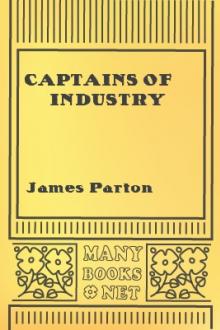Captains of Industry, James Parton [books to read for 12 year olds .txt] 📗

- Author: James Parton
- Performer: -
Book online «Captains of Industry, James Parton [books to read for 12 year olds .txt] 📗». Author James Parton
The son of an officer in the British army, he was educated at that famous Blue-Coat School which is interesting to Americans because Lamb and Coleridge attended it. At the age of fifteen he received an appointment as clerk in the office of Public Records. In due time, having proved his capacity and peculiar fitness, he was promoted to the post of Assistant Keeper, which gave him a respectable position and some leisure.
He proved to be in an eminent sense the right man in the right place. Besides publishing, from time to time, curious and interesting documents which he discovered in his office, he called attention, by a series of vigorous pamphlets, to the chaotic condition in which the public records of Great Britain were kept. Gradually these pamphlets made an impression, and they led at length to a reform in the office. The records were rearranged, catalogued, rendered safe, and made accessible to students. This has already led to important corrections in history, and to a great increase in the sum of historical knowledge.
When the subject of cheap postage came up in 1840, the government offered four prizes of a hundred pounds each for suggestions in aid of Sir Rowland Hill's plan. One of these prizes was assigned to Henry Cole. He was one of the persons who first became converts to the idea of penny postage, and he lent the aid of his pen and influence to its adoption.
At length, about the year 1845, he entered upon the course of proceedings which rendered him one of the most influential and useful persons of his time. He had long lamented the backward condition of arts of design in England, and the consequent ugliness of the various objects in the sight and use of which human beings pass their lives. English furniture, wall-papers, carpets, curtains, cutlery, garments, upholstery, ranged from the tolerable to the hideous, and were inferior to the manufactures of France and Germany. He organized a series of exhibitions on a small scale, somewhat similar to those of the American Institute in New York, which has held a competitive exhibition of natural and manufactured objects every autumn for the last fifty years.
His exhibitions attracted attention, and they led at length to the Crystal Palace Exhibition of 1851. The merit of that scheme must be shared between Henry Cole and Prince Albert. Cole suggested that his small exhibitions should, once in five years, assume a national character, and invite contributions from all parts of the empire. Yes, said Prince Albert, and let us also invite competition from foreign countries on equal terms with native products.
The Exhibition of 1851 was admirably managed, and had every kind of success. It benefited England more than all other nations put together, because it revealed to her people their inferiority in many branches both of workmanship and design. We all know how conceited people are apt to become who have no opportunity to compare themselves with superiors. John Bull, never over-modest, surveyed the Exhibition of 1851, and discovered, to his great surprise, that he was not the unapproachable Bull of the universe which he had fondly supposed. He saw himself beaten in some things by the French, in some by the Germans, in others by the Italians, and in a few (O wonder!) by the Yankees.
Happily he had the candor to admit this humiliating fact to himself, and he put forth earnest and steadfast exertions to bring himself up to the level of modern times.
Henry Cole was the life and soul of the movement. It was he who called attention to the obstacles placed in the way of improvement by the patent laws, and some of those obstacles, through him, were speedily removed.
During this series of services to his country, he remained in the office of Public Records. The government now invited him to another sphere of labor. They asked him to undertake the reconstruction of the schools of design, and they gave him an office which placed him practically at the head of the various institutions designed to promote the application of art to manufacture. The chief of these now is the Museum of South Kensington, which is to many Americans the most interesting object in London. The creation of this wonderful museum was due more to him than to any other individual.
It came to pass in this way: After the close of the Crystal Palace in 1851, Parliament gave five thousand pounds for the purchase of the objects exhibited which were thought best calculated to raise the standard of taste in the nation. These objects, chiefly selected by Cole, were arranged by him for exhibition in temporary buildings of such extreme and repulsive inconvenience as to bring opprobrium and ridicule upon the undertaking. It was one of the most difficult things in the world to excite public interest in the exhibition. But by that energy which comes of strong conviction and patriotic feeling, and of the opportunity given him by his public employment, Henry Cole wrung from a reluctant Parliament the annual grants necessary to make South Kensington Museum what it now is.
Magnificent buildings, filled with a vast collection of precious and interesting objects, greet the visitor. There are collections of armor, relics, porcelain, enamel, fabrics, paintings, statues, carvings in wood and ivory, machines, models, and every conceivable object of use or beauty. Some of the most celebrated pictures in the world are there, and there is an art library of thirty thousand volumes. There are schools for instruction in every branch of art and science which can be supposed to enter into the products of industry. The prizes which are offered for excellence in design and invention have attracted, in some years, as many as two hundred thousand objects. During three days of every week admission to this superb assemblage of exhibitions is free, and on the other three days sixpence is charged.
The influence of this institution upon British manufactures has been in many branches revolutionary. As the London "Times" said some time ago:—
"There is hardly a household in the country that is not the better for the change; there is certainly no manufacture in which design has any place which has not felt its influence."
The formation of this Museum, the chief work of Sir Henry Cole's useful life, was far from exhausting his energies. He has borne a leading part in all the industrial exhibitions held in London during the last quarter of a century, and served as English commissioner at the Paris exhibitions of 1855 and 1867.
This man was enabled to render all this service to his country, to Europe, and to us, because he was not obliged to waste any of his energies in efforts to keep his place. Administrations might change, and Parliaments might dissolve; but he was a fixture as long as he did his duty. When his duty was fairly done, and he had completed the fortieth year of his public service, he retired on his full salary, and he was granted an honorable title; for a title is honorable when it is won by good service. Henceforth he was called Sir Henry Cole, K. C. B.
To the end of his life he continued to labor in all sorts of good works—a Training School for Music, a Training School for Cookery, guilds for the promotion of health, and many others. He died in April, 1882, aged seventy-four years.
CHARLES SUMMERS.Strangers visiting Melbourne, the chief city of Australia, will not be allowed to overlook four great marble statues which adorn the public library. They are the gift of Mr. W. J. Clark, one of the distinguished public men of that growing empire. These statues represent, in a sitting posture, Queen Victoria, Prince Albert, the Prince of Wales, and the Princess of Wales. They are larger than life, and, according to the Australian press, they are admirable works in every respect.
They were executed by Charles Summers, a sculptor long resident in that colony, where he practiced his art with great success, as the public buildings and private houses of Melbourne attest. Many of his works remain in the colony, and he may be said to be the founder of his form of art in that part of the world. The history of this man's life is so remarkable that I think it will interest the reader.
Sixty years ago, Charles Summers was a little, hungry, ragged boy in English Somersetshire, who earned four cents a day by scaring the crows from the wheat fields. I have seen myself such little fellows engaged in this work, coming on duty before four in the morning, and remaining till eight in the evening, frightening away the birds by beating a tin pan with a stick, not unfrequently chasing them and throwing stones at them. He was the son of a mason, who had eight children, and squandered half his time and money in the tap-room. Hence, this boy, from the age of eight or nine years, smart, intelligent, and ambitious, was constantly at work at some such employment; and often, during his father's drunken fits, he was the chief support of the family.
Besides serving as scare-crow, he assisted his father in his mason's work, and became a hod-carrier as soon as he was able to carry a hod. Sometimes he accompanied his father to a distant place in search of employment, and he was often seen on the high-road, in charge of the drunkard, struggling to get him home before he had spent their united earnings in drink. In these deplorable circumstances, he acquired a dexterity and patience which were most extraordinary. Before he was twelve years old he began to handle the chisel and the mallet, and his work in squaring and facing a stone soon surpassed that of boys much older than himself. He was observed to have a strong propensity to do fancy stone-work. He obtained, as a boy, some local celebrity for his carved gate posts, and other ornamental objects in stone. So great was his skill and industry, that, by the time he was nineteen years of age, besides having maintained a large family for years, he had saved a sum equal to a hundred dollars.
Then a piece of good fortune happened to him. A man came from London to set up in a parish church near by a monumental figure, and looked about for a skillful mason to assist him. Charles Summers was mentioned as the best hand in the neighborhood, and upon him the choice fell. Thus he was introduced to the world of art, for this figure had been executed by Henry Weekes, a distinguished London sculptor. The hardships of his childhood had made a man of him at this early age, a thoughtful and prudent man. Taking with him ten of his twenty pounds, he went to London and applied for employment in the studio of Henry Weekes. This artist employed several men, but he had no vacant place except the humble one of stone polisher, which required little skill. He accepted the place with alacrity and delight, at a salary of five dollars a week.
He was now in his element. The lowliest employments of the studio were pleasing to him. He loved to polish the marble; the sight of the numerous models was a pleasure to him; even wetting the cloths and cleaning the model tools were pleasant tasks. His cheerfulness and industry soon made him a favorite; and when his work was done, he employed his





Comments (0)